 Title: Jeff Bezos’ company “Blue Origin” succeeds in taking the first commercial crew to space. 20 July 2021.
Title: Jeff Bezos’ company “Blue Origin” succeeds in taking the first commercial crew to space. 20 July 2021.
Blue Origin’s first successful commercial flight to space
Blue Origin
Blue Origin LLC (Limited Liability Company) is a private aerospace and sub-orbital spaceflight company established by the founder of Amazon, Jeff Bezos, in 2000.
Bezos started Amazon in 1994 as an online book selling company that quickly grew to become a business success and an online retail giant, now regarded as "one of the most influential economic and cultural forces in the world", and “the world's most valuable brand”.
After launching four commercial astronauts on an autonomous return flight to space on 20 July 2021, Blue Origin demonstrate that suborbital space is safe for everyone.
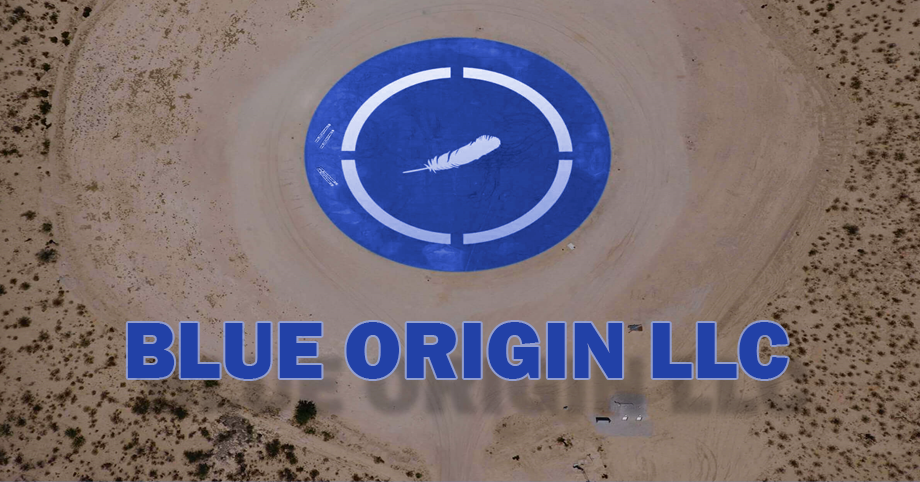 Blue Origin LLC aerospace company, funded by Jeff Bezos in 2000. Blue Origin, 2021.
Blue Origin LLC aerospace company, funded by Jeff Bezos in 2000. Blue Origin, 2021.
The Rocket
New Shepard is Blue Origin’s reusable, fully autonomous, suborbital rocket system consolidate into an 18-metre-tall spaceship propelled by a BE3 engine running on liquid Hydrogen and Oxygen, one of the cleanest burning fuels around. Combustion of these gases results in the emission of water vapour and a trace of Nitrogen Oxide (NOx) into the atmosphere. The NOx is produced by the combination of oxygen with the abundant Nitrogen in the Troposphere (the lowest 10 km of the atmosphere).
The vehicle can reach speeds of 3,540 kph and climb above the Karman Line at 100km of altitude, a boundary recognised by the “Federation Aeronautique Internationale” as the edge of space.
The rocket system was named after NASA’s astronaut Alan Shepard, the first American that reached space in May 1961 on a mission with a similar profile. He became the second human in space after Yuri Gagarin who flew a month earlier for the Soviet Union.
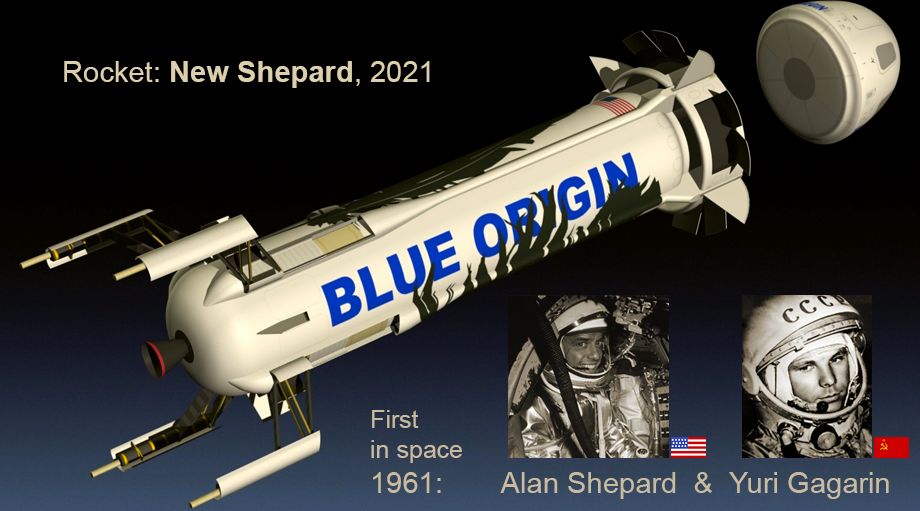 Rocket: New Shepard, 2021. Named after Alan Shepard, the second human in space after Yuri Gagarin in early 1961. Blue Origin, 2021.
Rocket: New Shepard, 2021. Named after Alan Shepard, the second human in space after Yuri Gagarin in early 1961. Blue Origin, 2021.
The New Shepard rocket system composed of Booster and Capsule were successfully tested on 15 April 2021 in preparation for the first flight with a commercial crew.
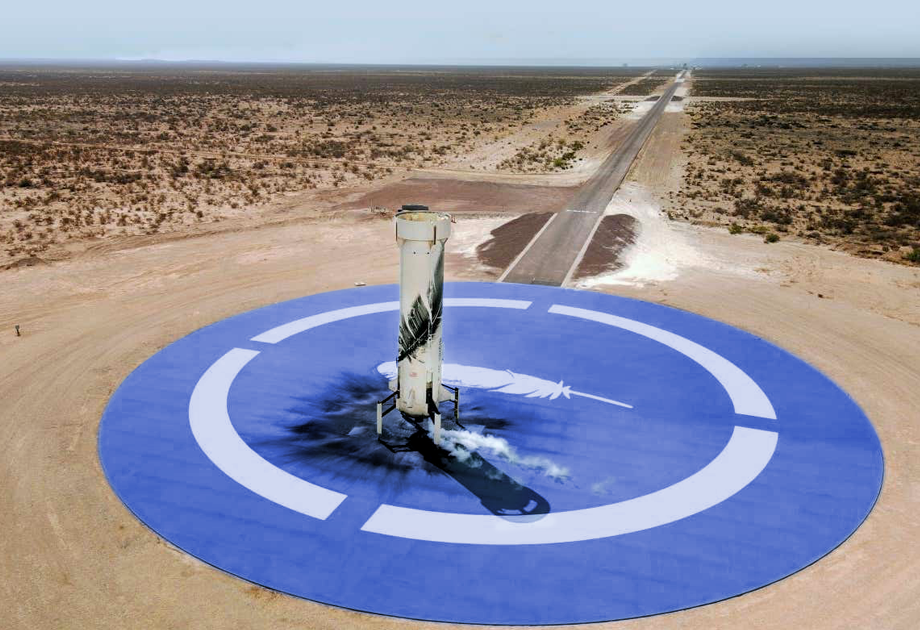 The New Shepard rocket booster successful landed on the Blue Origin launch pad after a test flight on 15 April 2021. Blue Origin, 2021.
The New Shepard rocket booster successful landed on the Blue Origin launch pad after a test flight on 15 April 2021. Blue Origin, 2021.
Crew of four
The crew onboard New Shepard’s capsule consisted of: Oliver Daemen, Jeff Bezos, Ms Wally Funk and Mark Bezos.
Jeff and Mark Bezos are the first siblings to fly in space together (NASA twin astronauts Mark and Scott Kelly were scheduled to meet at the ISS in 2010 but Scott’s mission, STS-134, was delayed and ended the possibility of the first meeting of blood relatives in space).
Oliver Daemen is an 18-year-old student from the Netherlands, the youngest paying customer in space. Although the price of the ticket was not disclosed, his father outbid and anonymous bidder who offered $28 million at an auction that started with a bid of $4.8 million.
Wally Funk is an 82-year-old pilot and ex-astronaut candidate who trained with a group of 25 woman for NASA's Mercury mission in 1961, 13 of whom graduated, and were known as the “Mercury 13”. Subsequently, the programme was cancelled, and she did not make it to space. Wally became the first female flight instructor at a US military base and since 1974 worked as air-safety investigator retiring in 1985, when she was appointed an FAA Safety Counselor.
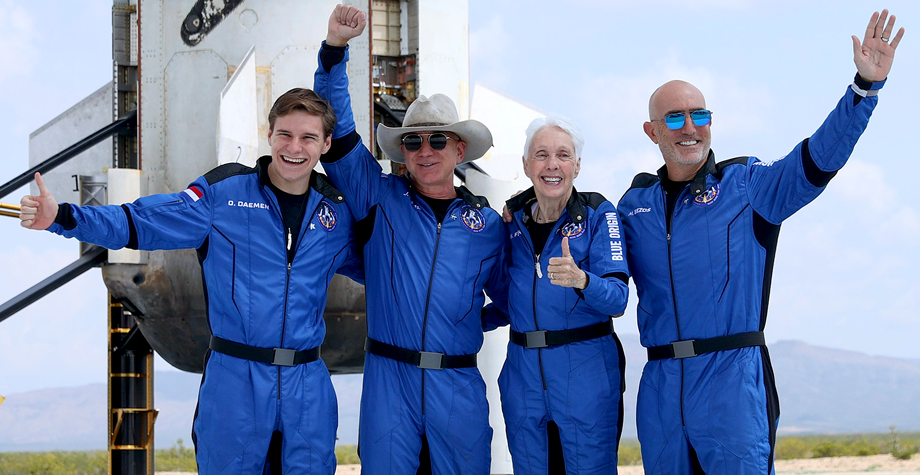 The crew on board Blue Origin’s first commercial space flight: Oliver Daemen, Jeff Bezos, Wally Funk and Mark Bezos. Blue Origin, 20 July 2021.
The crew on board Blue Origin’s first commercial space flight: Oliver Daemen, Jeff Bezos, Wally Funk and Mark Bezos. Blue Origin, 20 July 2021.
The flight
The first Blue Origin commercial flight to space launched from Texas in the early hours of 20 July 2021. The launch was a total success following procedures that were rehearsed and polished in 15 consecutive test missions since the beginning of development in 2012.
The autonomous vehicle began its pre-defined journey under the watchful eye of the ground crew who were monitoring every aspect of the event from the control centre in West Texas.
 New Shepard rocket at engine ignition on the launch pad. One second into the flight. Blue Origin, 20 July 2021.
New Shepard rocket at engine ignition on the launch pad. One second into the flight. Blue Origin, 20 July 2021.
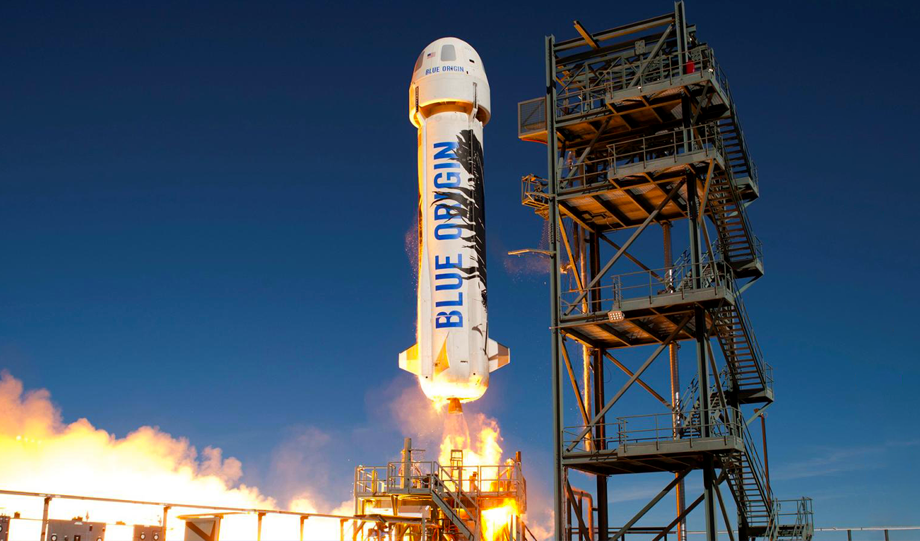 New Shepard rocket. Lift off. Blue Origin, 20 July 2021.
New Shepard rocket. Lift off. Blue Origin, 20 July 2021.
 New Shepard rocket and launch pad in the Texan desert. Blue Origin, 20 July 2021.
New Shepard rocket and launch pad in the Texan desert. Blue Origin, 20 July 2021.
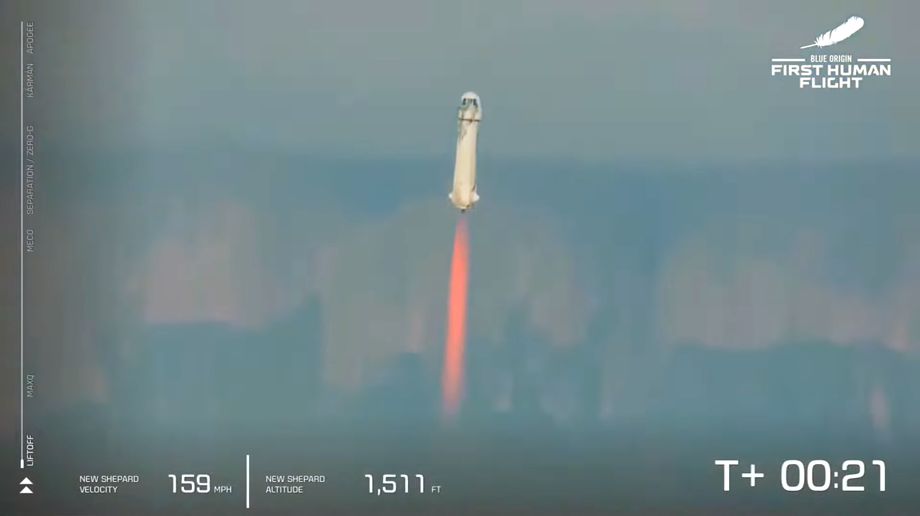 New Shepard rocket climbing. Blue Origin, 20 July 2021.
New Shepard rocket climbing. Blue Origin, 20 July 2021.
One minute into the flight, the vehicle crossed the Maximum Dynamic Pressure point (MAX/Q), which is the maximum pressure that the crew was exposed to while the rocket ascended at a velocity of 864 kph and an altitude of 6,4 km above Mean Sea Level (MSL).
The rocket reached the maximum ascending speed of 3,585 kph at an altitude of 57 km, 2min, 20sec into the mission. Thirteen kilometres above the Main Engine Cut Off (MECO) point the vehicle entered the ZERO-G zone, slowing down to 1,841 kph in preparation for the separation of the crew’s capsule from the booster.
The booster or first stage, began its autonomous descent towards the landing pad.
Three and a half minutes after launch, the capsule crossed the Karman Line at 100 km, officially entering space and therefore promoting her passengers to Astronauts. The spaceship slowed down further and reached her maximum expected altitude (Apogee) of 107 km above MSL.
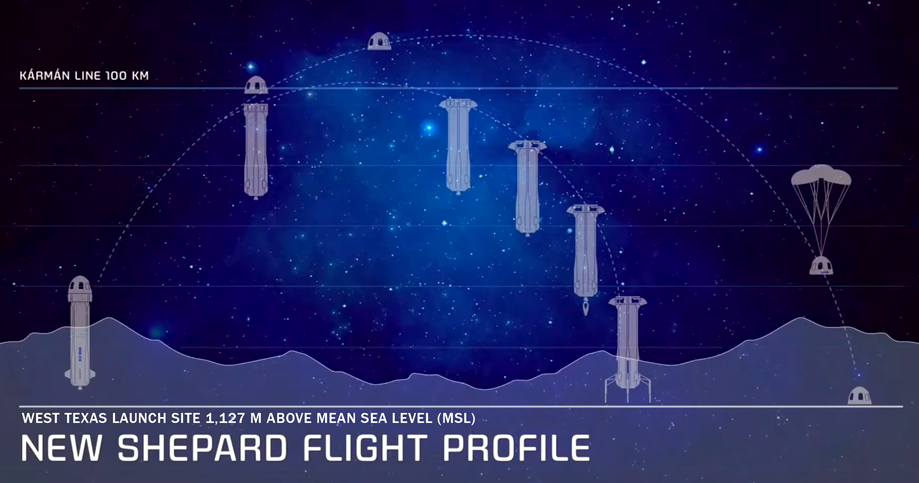 New Shepard flight profile. The crew capsule passed the Karman line at 100 km of altitude, the edge of space. Blue Origin, 20 July 2021.
New Shepard flight profile. The crew capsule passed the Karman line at 100 km of altitude, the edge of space. Blue Origin, 20 July 2021.
Zero gravity
Finally, when the capsule stopped ascending at 0 kph the mission reached its destination. The astronauts were allowed to release their seatbelts and experienced floating in zero gravity for four minutes, enjoying a magnificent view of our planet from the edge of space.
Booster’s return
Five minutes into the journey and while the crew were enjoying weightlessness, the booster was on its way to the surface, gradually gaining speed as it fell towards Earth in a curved trajectory. Two minutes later it reached a speed of 616 kph, correcting its attitude with a set of grid-fins located near the top of the structure and keeping the engine leading the way as the heaviest part of the vehicle.
At 1km from the ground, the engine reignited and rapidly slowed down the descent, taking control of the precise vertical landing.
 New Shepard Booster approaching the launch pad during vertical landing. Blue Origin, 20 July 2021.
New Shepard Booster approaching the launch pad during vertical landing. Blue Origin, 20 July 2021.
Seven minutes and twenty-one seconds after launch, the New Shepard rocket booster touched down safely on the Blue Origin landing pad.
 New Shepard Booster landing on the Blue Origin launch pad, West Texas. Blue Origin, 20 July 2021.
New Shepard Booster landing on the Blue Origin launch pad, West Texas. Blue Origin, 20 July 2021.
Successful landing of the reusable booster.
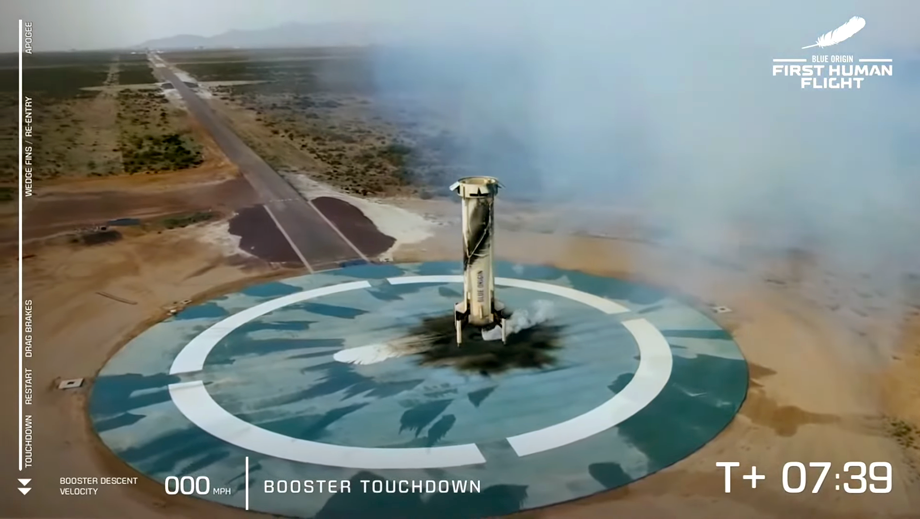 New Shepard Booster safely landed autonomously on the Blue Origin launch pad, West Texas. Blue Origin, 20 July 2021.
New Shepard Booster safely landed autonomously on the Blue Origin launch pad, West Texas. Blue Origin, 20 July 2021.
Capsule’s return
While the booster landed safely, the capsule was still descending, reaching a top falling speed of 366 kph at an altitude of 3 km. Eight minutes, 22 seconds into the mission, 3 small “Drogue” parachutes were deployed, slowing down the capsule from 329 to 240 kph. Ten seconds later, when the capsule was at 765 m from the ground, the 3 main parachutes were deployed, slowing down the capsule gradually to 25 kph.
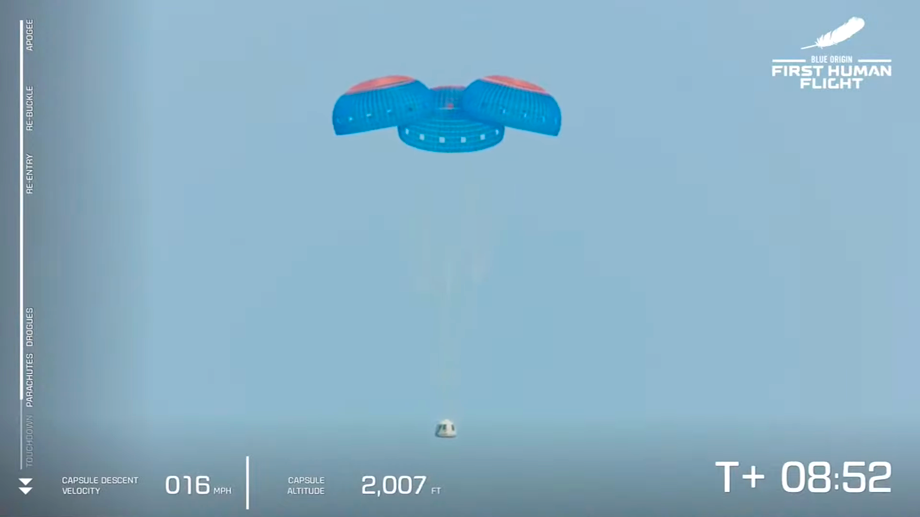 Capsule’s descent slowed down by main parachutes. Blue Origin, 20 July 2021.
Capsule’s descent slowed down by main parachutes. Blue Origin, 20 July 2021.
Two metres before touching the ground the capsule shot a set of air jets to cushion the landing.
From launch to touch-down, the mission took 10 minutes and 10 seconds.
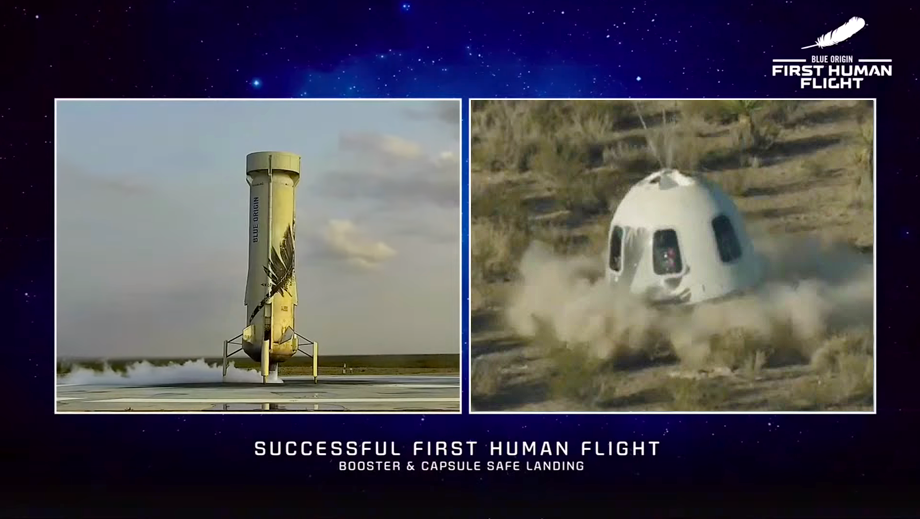 New Shepard’s booster and capsule landed safely after a successful first commercial flight to space. Blue Origin, 20 July 2021.
New Shepard’s booster and capsule landed safely after a successful first commercial flight to space. Blue Origin, 20 July 2021.
The jubilant crew descended from the capsule to greet family, friends and Blue Origin staff who congregated around the capsule when the site was secured.
 The crew of Blue Origin first commercial flight descending from the capsule after their successful landing in Western Texas, USA. Blue Origin, 20 July 2021.
The crew of Blue Origin first commercial flight descending from the capsule after their successful landing in Western Texas, USA. Blue Origin, 20 July 2021.
Launch Video
The following video shows the highlights of New Shepard’s flight on 20 July 2021. Blue Origin’s commentators follow the events from launch to landing (12min).
Post-flight press conference
Following the success of the first commercial flight to space, the astronaut crew of New Shepard attended a post-flight conference.
Oliver Daemen, Mark Bezos, Jeff Bezos and Wally Funk commented on the most exciting experience of their lives. Ariane Cornell, Director of Astronaut Sales was the host of the event.
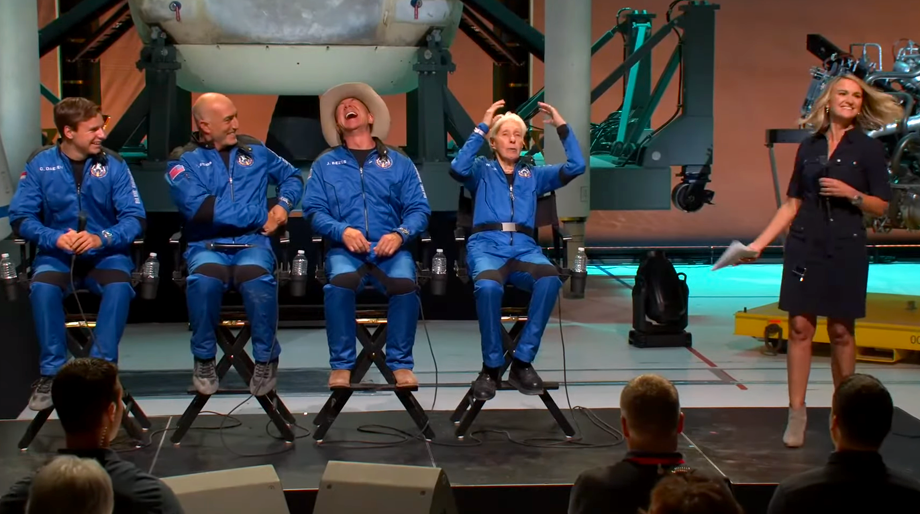 The crew of Blue Origin first commercial flight at a post-flight press conference: Oliver Daemen, Mark Bezos, Jeff Bezos and Wally Funk. Ariane Cornell was the master of ceremony. Blue Origin, 20 July 2021.
The crew of Blue Origin first commercial flight at a post-flight press conference: Oliver Daemen, Mark Bezos, Jeff Bezos and Wally Funk. Ariane Cornell was the master of ceremony. Blue Origin, 20 July 2021.
The first Blue Origin astronauts were awarded their “wings”, a pin in the shape of the letter “A” in which the side pieces represent the road to space, crossed by the Blue Origin’s feather logo. At the top, the pin has a blue sapphire that represents the Earth, to remind them of their mission to protect their home planet.
The wings were presented by Jeff Ashby, Senior Director of Safety and Mission Assurance at Blue Origin and former Space Shuttle Commander.
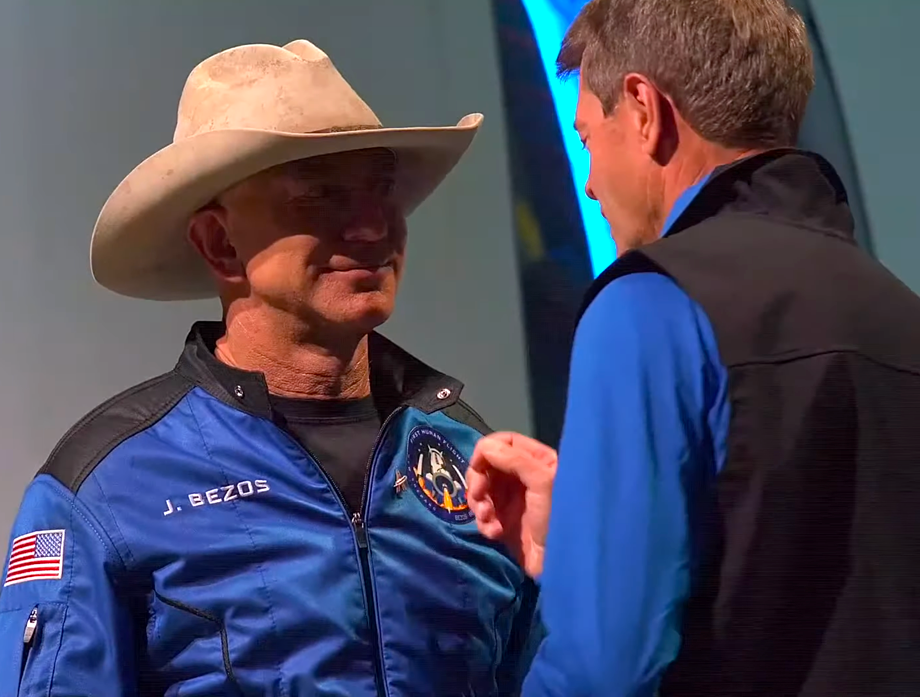 Jeff Bezos receiving his Astronaut Wings from Jeff Ashby on behalf of the Blue Origin employees. Blue Origin, 20 July 2021.
Jeff Bezos receiving his Astronaut Wings from Jeff Ashby on behalf of the Blue Origin employees. Blue Origin, 20 July 2021.
Jeff Bezos acknowledged the contribution of the engineering team and the staff at Blue Origin who worked tirelessly to make this project a reality. He also thanked employees and customers of Amazon, who paid for the mission. The new astronauts commented on their experience in zero gravity and how the Earth looks from such an altitude. Bezos recognised that the spacecraft choices were an overkill for space tourism and explained that the purpose of this first commercial mission was to test the technology and learn from it with the intention of scaling for future missions, which will have larger loads and more distant targets.
Blue Origin expects to launch two more missions in 2021 and flights will become more frequent as they improve on their efficiency. Following an increased public interest in spaceflight, the company has already raised close to US$100 million to fund their upcoming efforts.
Space tourism is now a reality, and this is the beginning of a substantial endeavour that will become more accessible in the future.
A new award
Bezos announced a new philanthropic initiative, the “Courage and Civility Award”, to recognise the humanitarian contribution of leaders who aim high and pursue solutions with courage and civility, those who are courageous and unifiers. The awardee receives US$100 million to give to charities and non-profit organisations of their choice.
The first two awardees were Jose Andres, a Spanish chef and humanitarian, founder of World Central Kitchen, and Van Jones, founder of Dream Corps.
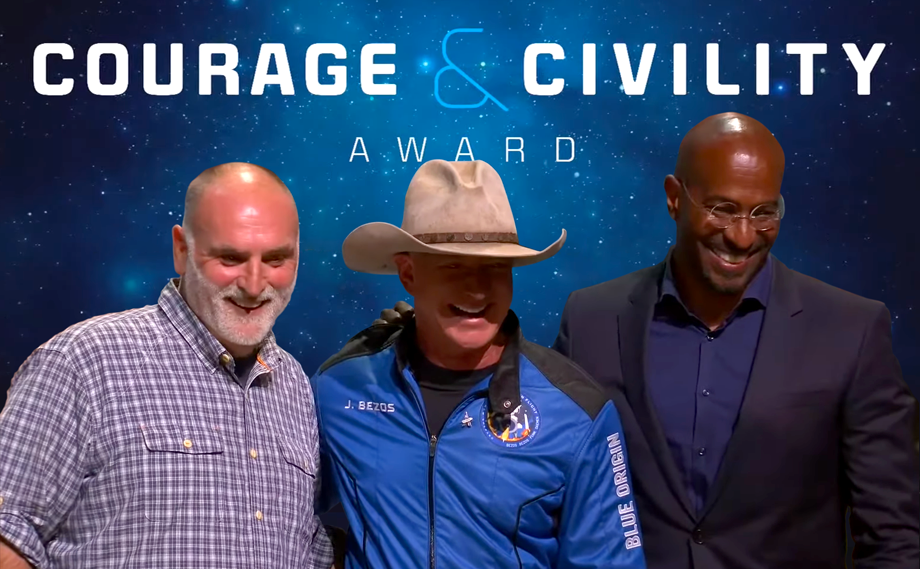 Jose Andres (left) and Van Jones (right), were the first to receive the “Courage and Civility Award” worth US$100 million from Jeff Bezos (middle) at Blue Origin’s post-flight conference. Blue Origin, 20 July 2021.
Jose Andres (left) and Van Jones (right), were the first to receive the “Courage and Civility Award” worth US$100 million from Jeff Bezos (middle) at Blue Origin’s post-flight conference. Blue Origin, 20 July 2021.
Watch the full post-flight press conference (49 min).
A Virgin rocket plane was the first to reach space
On 11 July 2021, Englishman Sir Richard Branson reached the edge of space on the first commercial flight of his company Virgin Galactic.
The piloted flight crossed the 80 km altitude line considered space altitude by the US Federal Aviation Administration.
 Virgin Galactic’s rocket plane successfully reached space. Virgin Galactic, 11 July 2021.
Virgin Galactic’s rocket plane successfully reached space. Virgin Galactic, 11 July 2021.
The vehicle was a rocket plane that took 17 years to developed and was piloted by Dave Mackay and Michael Masucci. Richard Branson was accompanied by Virgin Galactic employees Colin Bennett, Beth Moses and Sirisha Bandla on a demonstration flight that opened up the gates of space tourism.
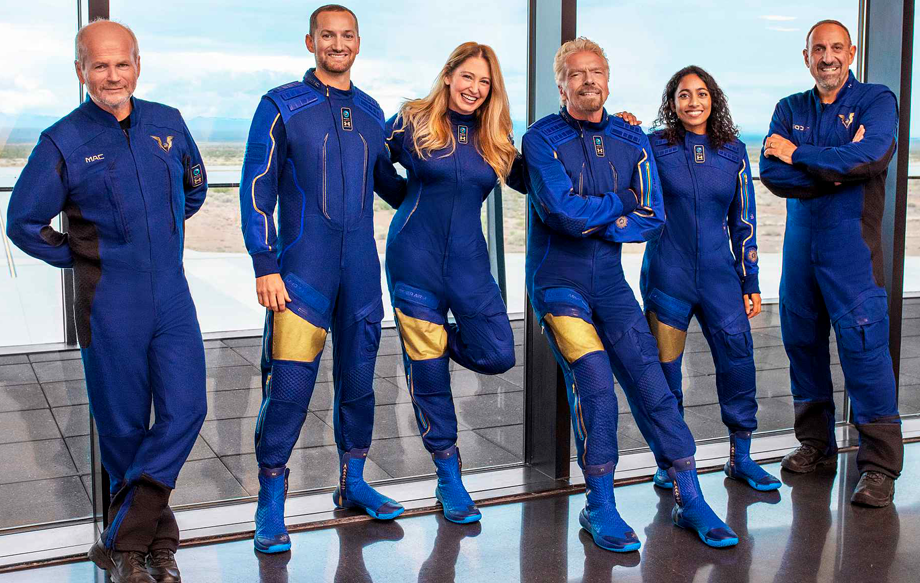 The crew of the first commercial flight: Pilot Dave Mackay, Colin Bennett, Beth Moses, Richard Branson, Sirisha Bandla and Pilot Michael Masucci. Virgin Galactic, 11 July 2021.
The crew of the first commercial flight: Pilot Dave Mackay, Colin Bennett, Beth Moses, Richard Branson, Sirisha Bandla and Pilot Michael Masucci. Virgin Galactic, 11 July 2021.
The crew of Virgin Galactic floating in zero gravity during their first flight to space.
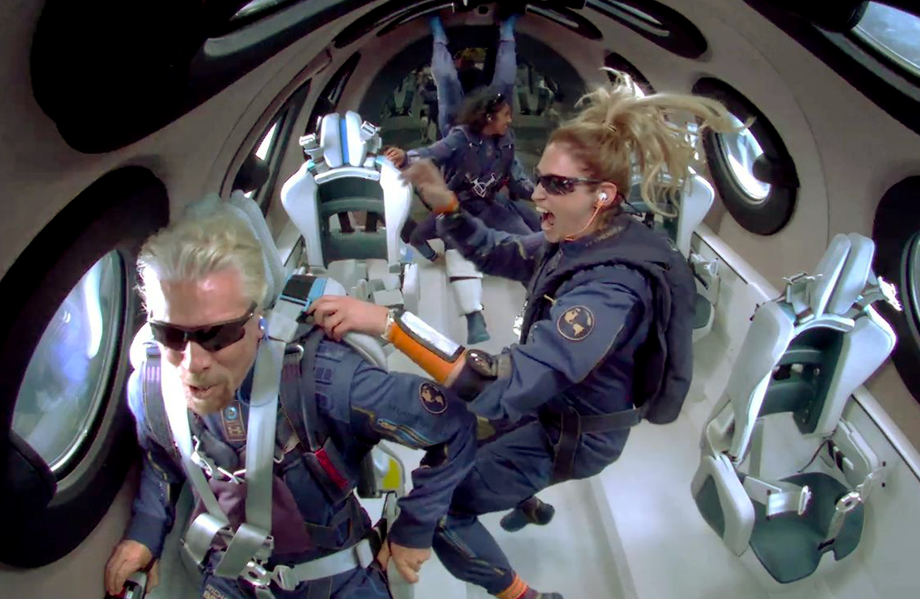 The crew of Virgin Galactic floating in space onboard the rocket-plane. Virgin Galactic, 11 July 2021.
The crew of Virgin Galactic floating in space onboard the rocket-plane. Virgin Galactic, 11 July 2021.
With three major private companies offering a “ride of a lifetime” to space (Space-X, Blue Origin and Virgin Galactic), the future of commercial sub-orbital flights is looking brighter than ever.
REFERENCES
2. » CNET (2021) Watch Blue Origin launch Jeff Bezos to space! (Beyond Karman Line). CNET Highlights [Online video]. Available here. (Accessed: 20 July 2021).
3. » CNET (2021) Watch Jeff Bezos and Wally Funk in zero gravity during Blue Origin spaceflight. CNET Highlights [Online video]. Available here. (Accessed: 20 July 2021).
4. » Blue Origin (2021) Blue Origin safely launches four commercial astronauts to space and back, 20 July 2021. [Online article]. Available here. (Accessed: 20 July 2021).
5. » Wikipedia (2021) Wally Funk. [Online article]. Available here. (Accessed: 20 July 2021).
6. » Virgin Galactic (2021) Wally Funk. [Online article]. Available here. (Accessed: 20 July 2021).
7. » Mann A (2021) How much will Jeff Bezos' New Shepard rocket warm the planet? Live Science, 19 July 2021. [Online article]. Available here. (Accessed: 20 July 2021).
8. » Kordina F (2020) What is the environmental impact rockets have on our air? Everyday Astronaut, 20 March 2020. [Online article]. Available here. (Accessed: 20 July 2021).
=== END OF ARTICLE: "First Commercial Flight to Space - 20 July 2021" ===